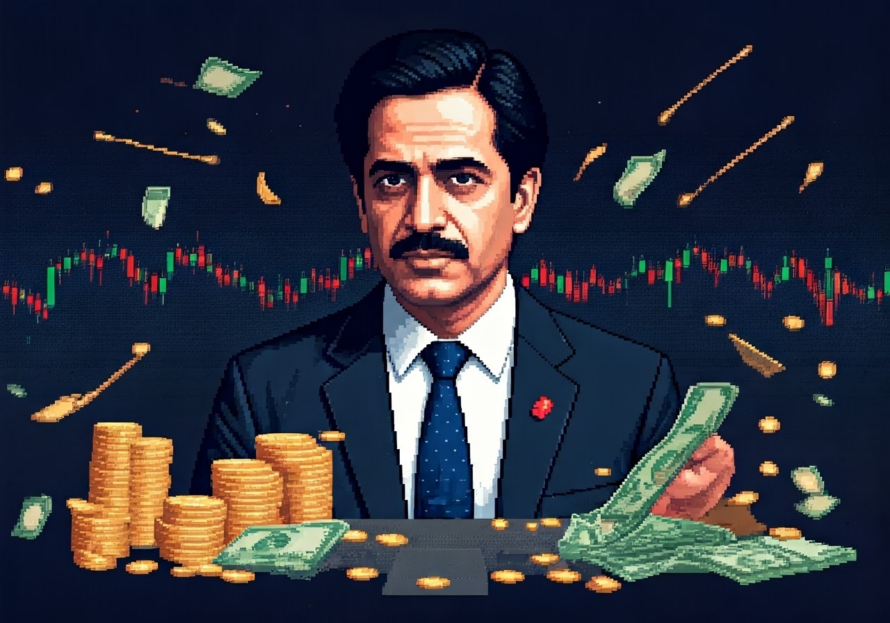
Key Highlights
- Harshad Mehta, a stockbroker dubbed ‘The Big Bull,’ orchestrated the largest securities scam in India’s history in 1992.
- Mehta exploited loopholes in the banking system, particularly the ready-forward deal system and bank receipts (BRs), to siphon funds into the stock market.
- He manipulated stock prices of companies like ACC, creating a bull run that eventually crashed, wiping out billions in investor wealth.
- The scam led to significant reforms in the Indian stock market, including the establishment of SEBI as a regulatory body and the introduction of electronic trading.
- The events continue to be debated, with some viewing Mehta as a financial wizard and others as a fraudster.
Introduction
The Indian stock market faced a huge shock in 1992, known as the Harshad Mehta scam. This famous case showed how weak the financial system was and how easily people could trick it. Harshad Mehta’s story is one of big dreams, smart moves, and a tragic end. It uncovered a mixed-up plot with brokers, banks, and government securities involved. Let’s break down the details of the scam and look at how it still affects the Indian stock market today.
The Prelude to Scam 1992
Understanding India’s economy in the early 1990s is important to see how big the Harshad Mehta scam was. India was ready to liberalize, and the government was starting to open the economy. This time of change led to both new ideas and chances for wrongdoing.
The financial markets were very active. The Bombay Stock Exchange, the center of Indian stock trading, experienced unusual ups and downs. It was during this period of change that Harshad Mehta, a typical stockbroker, rose to fame.
The Financial Landscape of India in the Early 90s
The Indian financial markets changed a lot in the early 1990s. The government introduced liberalization policies, which led to increased activity at the Bombay Stock Exchange (BSE). Before that, the markets were tightly controlled, but now stock prices started to change more, showing both excitement and worry about the economic reforms.
This liberalization brought both chances and problems. The rules that governed the financial markets were not strong enough to handle the increased activity. They could not stop bad practices. The rules that were there were made for a more controlled situation and weren’t able to keep up with the clever ideas of some people who wanted to take advantage of the system.
The arrival of new investors, along with the relaxed rules, created an environment filled with speculation. In this time of financial hope and unclear regulations, Harshad Mehta’s schemes began to grow.
Harshad Mehta: The Man Behind the Scandal
Harshad Mehta, known as the ‘Big Bull,’ began his career as a small trader on the Bombay Stock Exchange. He had big dreams and quickly moved up in the ranks. Mehta was famous for his bold trading style and keen sense of market trends.
He attracted investors with his charm and seemed to promise high returns. His fast rise to fame came from a mix of clever strategy, risky bets, and illegal activities that made him a well-known name in the stock market.
However, people soon started to question his methods. While he appeared to be a skilled investor, Mehta was secretly taking advantage of the system. He used illegal ways to support his risky investments, which ended up hurting the whole market.
The Build-Up to the Stock Market Frenzy
Harshad Mehta’s actions sparked a historic rise in the Indian stock market. The BSE Sensex, which is the main index of the Bombay Stock Exchange, reached new heights because of Mehta’s trading tricks. Investor confidence grew quickly.
Small investors, tempted by easy money, invested their savings in the market. This made the bubble grow even bigger. Mehta’s success became famous. Many people, excited to join this great trend, wanted to get in on it.
But this growth was not real. The high stock prices were not based on actual company performance. They were pushed up by Mehta’s dishonest methods. What looked like a golden time for the Indian stock market was actually a dangerous situation waiting to happen.
Understanding the Mechanics of Scam 1992
Harshad Mehta’s scam focused on using the gaps in India’s banking system. He wanted to boost stock prices for his own benefit. Mehta created a complex scheme that involved changing a financial tool called bank receipts, or BRs.
BRs are supposed to be short-term tools for banks to lend against government securities. However, Mehta used fake BRs. He presented these fake documents as proof to get more money. This way, he created a huge fake supply of cash.
The Role of Bank Receipts in the Scam
Bank receipts, or BRs, played a key role in Harshad Mehta’s fraud. Banks used these documents for short-term loans based on government securities. They acted as proof of ownership, but Mehta took advantage of the weak rules and oversight around BRs.
He created fake BRs, which were false documents that claimed he owned specific government securities. By showing these fake BRs, he got huge loans from banks, even though he didn’t have the real securities to support these loans.
This scheme worked because people trusted these financial institutions a lot. Transactions were also done very quickly. A network of banks and financial institutions, either knowingly or unknowingly, became part of Mehta’s complex scam, enabling the illegal movement of money.
How Harshad Mehta Exploited the Banking System
Harshad Mehta knew the banking system very well. He understood the money market and how rules about it worked, or sometimes didn’t work. He saw that banks had to keep some of their money in government securities. This created a strong demand and a lot of trading.
Mehta became a go-between, using fake BRs to connect the banks. Since the real securities were never handed over, he took the cash from selling these fake BRs to support his market tricks.
He also found a mistake in the ready-forward deal system. In this system, banks would lend and borrow short-term money using government securities as collateral. By playing with this process, he was able to get more money, which made his scheme even bigger.
The Involvement of Brokers and Financial Institutions
Harshad Mehta was the main person behind the scam, but it only worked because many others in the financial system helped him or failed to act. Mehta’s brokerage firm was the link for these illegal deals, allowing him to put the stolen money into the stock market.
Some people in banks and financial institutions, driven by greed or pressure to make a lot of money, ignored red flags. This helped Mehta continue his operations without anyone noticing.
Also, some brokerage firms, seeing a chance to benefit from the rising market, took part in Mehta’s tricks. They pushed stock prices up to levels that could not be maintained. This wide-ranging teamwork, filled with greed, carelessness, and a lack of responsibility, ultimately caused the system to collapse.
Key Players in the Scam and Their Roles
The Harshad Mehta scam was not just about one person. Many individuals and organizations took part, some knowingly and some unknowingly. It’s important to look at these key players to grasp how complicated the fraud was.
From Mehta’s close associates who handled money and planned trades to bank workers who allowed his plans to continue, and to the regulatory groups that missed red flags, blame is shared among many. Examining their reasons and actions gives us a better view of how big the scam was and its effects.
Harshad Mehta’s Inner Circle
Harshad Mehta’s close group included brokers, banks, and important people in the stock market. One of them was Sucheta Dalal, a journalist. She revealed the scam in her reports for the Times of India. Mehta changed stock prices, government securities, and the banking system to create a bull run. His partners in the brokerage firm helped him manipulate the market. This caused big losses for small investors. Even with charges of criminal breach of trust against him, his circle stayed loyal and supported him during the accusations and legal challenges. Mehta’s network was key in carrying out India’s worst financial scandal.
Banks and Their Complicity
The banks played an important role in Harshad Mehta’s scam. The State Bank of India (SBI) and smaller banks like the Bank of Karad were involved. Some banks might not have known what Mehta was really doing at first, but they got deeper into the scam as it went on.
People in these banks, attracted by the chance to make more money or help Mehta in exchange for personal gains, helped him carry out his illegal actions. They issued fake BRs, moved funds wrongly, and ignored rules, all while they were supposed to protect the banking system.
The consequences for these banks, especially SBI, were large. They lost their reputation, faced stricter rules, and got more attention from the public. These events showed that the banking sector needed better internal controls, ethical behavior, and more accountability.
Regulatory Failures: SEBI and the Reserve Bank of India
The Harshad Mehta scam showed serious problems in India’s financial system. The Securities and Exchange Board of India (SEBI) could not manage the fast-growing stock market. They did not have the power or tools needed to oversee everything effectively.
The Reserve Bank of India (RBI) is in charge of regulating banks, but they also missed signs of wrongdoings. They could not stop issues like the misuse of bank receipts and breaking lending rules. The slow and weak regulatory framework helped Mehta’s tricks continue without being stopped.
This huge wake-up call made leaders act. SEBI was given more authority, new regulations were set, and monitoring of financial markets improved. However, this change came at a cost. It caused investors to lose confidence and showed how easily the system could be manipulated.
The Unraveling of Scam 1992
The carefully built house of cards created by Harshad Mehta started to fall apart when journalist Sucheta Dalal, with insider knowledge, wrote a detailed article in the Times of India. This article pointed out problems in Mehta’s activities with the State Bank of India.
This discovery shocked the financial system. It set off a series of events. Regulators rushed to act, investigations began, and the stock market, filled with panic and worry, dropped sharply. The man who was once seen as a financial genius was now facing serious accusations. He was blamed for running the biggest financial scam in India’s history.
The Exposé by the Media
On April 23, 1992, the Times of India shared an important article by journalist Sucheta Dalal. She investigated Harshad Mehta and uncovered strange activities hinting at a bigger scam in the financial markets.
Dalal’s careful reporting revealed problems in Mehta’s interactions with banks, especially the State Bank of India. The article didn’t name Mehta directly but referred to him as a ‘Big Bull,’ a nickname many used for him.
This press release shocked the financial world. It was the start of Mehta’s downfall, putting him in the spotlight and making regulators begin investigations. Dalal’s work was key in uncovering the truth and bringing Mehta to justice.
Immediate Reactions from the Stock Market
The news from Sucheta Dalal shocked the stock market. People were in disbelief and panic. Investors struggled to accept the idea of market manipulation. As a result, the BSE Sensex, which measures the Bombay Stock Exchange, dropped sharply.
The popular bull run, led by Harshad Mehta, quickly fell apart. When the truth was revealed, investors feared losing money. This fear caused many to sell their stocks quickly, which made prices go down greatly.
The crash showed how weak the market was. It was based on speculation and lies. The Sensex, which had risen high in recent months, fell suddenly. This drop erased billions of rupees in investor wealth and broke the idea that the market would always do well.
Government and SEBI’s Response
The Indian government reacted quickly to the growing crisis. They saw how big the scam was and how it could shake the whole financial system. To regain trust, the government took action. They started investigations, and the Reserve Bank of India stepped in to calm investors and stop a total collapse of the banking system.
The Securities and Exchange Board of India (SEBI), then a new regulatory body, faced a lot of pressure to take control. The scam showed that the current regulatory framework was not enough and that reforms were needed right away.
New rules were put in place to stop similar scams from happening again. SEBI received more powers, trading of government securities became clearer, and steps were taken to better watch financial markets.
Legal Battles and Fallout
The Harshad Mehta scam caused many legal fights and had significant impacts on the Indian financial system. Mehta faced several serious charges, such as fraud, forgery, and criminal breach of trust.
This scam set off a chain reaction. It revealed problems within banks and financial institutions. As a result, there were stricter rules, closer inspections, and a stronger focus on corporate governance to stop such big issues from happening again.
Harshad Mehta’s Arrest and Trial
In November 1992, just a few months after the scam was uncovered, Harshad Mehta was arrested. He faced many serious charges, like criminal conspiracy, cheating, forgery, and criminal breach of trust. This started a long legal battle that caught the attention of the whole nation.
Mehta, who was once seen as a role model for success, was now up against the law. His trial became a big media story, with everyone watching closely. Even with the serious charges, Mehta said he was innocent and that he was simply a pawn in a broader scheme.
The case eventually went to the Supreme Court, where Mehta was found guilty of some charges. Although his sentence was shortened due to his poor health and death in 2001, the legal case had a big impact. It helped shape new laws and made it clearer what is acceptable in the Indian stock market.
Impact on the Banking Sector
The Harshad Mehta scam caused major trouble in the Indian banking sector. It showed the weaknesses in the system and made people lose trust in the banks. The banks directly involved in Mehta’s plans faced a lot of damage to their reputation.
This scam revealed how banks lacked strong internal controls. Because of this, money was misused, and rules could easily be sidestepped. The public’s faith in financial institutions was shaken, leading to a review of how risks were managed.
As a result of this crisis, the Reserve Bank of India had to make tough changes. The banking system saw major updates. These included stricter lending rules, better verification processes, and a stronger focus on following the rules. These steps aimed to stop future scams and protect the integrity of the financial system.
Reforms and Changes in Regulations
The Harshad Mehta scam changed India’s financial market rules completely. This event showed big problems in the system and pointed out that stronger regulations were needed.
One major result of the scam was that SEBI got stronger. The Securities and Exchange Board of India went from being weak to gaining the power to regulate the stock market better.
New rules were added to make transactions clear, stop market manipulation, and safeguard investor interests. The scam led to electronic trading, changes to shares, and stricter rules for trading in government securities. These changes changed the way India’s financial system works.
Personal Stories: Victims and Beneficiaries
The Harshad Mehta scam is often talked about because of its effect on institutions and rules. However, we should not forget about the people affected. The scam caused a lot of financial harm to many individuals across the country.
Small investors lost their life savings. Employees of the banks that were affected had to deal with uncertainty. Their personal stories help us understand how deeply this scam affected so many lives. While a few people might have gained from Mehta’s schemes, many others suffered serious consequences.
The Common Investors: Dreams Shattered
The Harshad Mehta scam hit small investors the hardest. Many of these investors were new to the stock market. They were drawn in by the chance to make quick money during the bull run. These retail investors often did not fully understand the complex market. They invested their hard-earned savings into stocks, chasing after big returns.
Sadly, when the market crashed, their hopes for financial security fell apart. These investors were not ready for such a sudden drop. They found themselves losing a lot of money and getting trapped in a downward spiral. This scam made them lose faith in the stock market. It brought fear and doubt about investing.
This event showed how important it is for people to understand finance. Small investors need to be careful. They should do their research and not get carried away in fast-rising market trends.
Windfall Gains: The Other Side of the Coin
Many people lost a lot after the Harshad Mehta scam. However, a few others made temporary profits. These were the individuals or groups who either planned ahead or had special information. They sold large quantities of stocks before the market crashed.
They took advantage of the fake bull run caused by Mehta’s actions. They made a lot of money selling stocks at high prices. This sudden cash made people uneasy and raised concerns about fairness and insider trading.
Sadly, these profits did not last long. Investigations followed and led to a close look at suspicious trading. Those who gained from illegal actions, like insider trading, faced legal troubles. They lost their unfair profits and had to pay penalties.
The Aftermath of Scam 1992
The Harshad Mehta scam had a big effect on more than just the stock market and those directly involved. It created a lasting impact on the Indian financial system. This event changed how people viewed finance and influenced rules for a long time.
It showed the need for transparency and responsible practices in finance. This led to a stronger and more trusted market, but the lessons from the scam still remind us to be careful.
Long-Term Effects on the Indian Stock Market
The Harshad Mehta scam had a big impact on the Indian stock market. It hurt investor confidence, and this took a long time to rebuild. Small investors became careful about market manipulation. They chose to invest in traditional ways instead of equity markets.
The scam showed the risks of too much speculation and the serious problems caused by unregulated market manipulation. It highlighted the need for good corporate governance, clear trading practices, and better protection for investors.
On the positive side, the scam led to important changes. New rules and stricter enforcement were put in place. Increased awareness among investors helped rebuild their confidence in the market. This helped transform the financial system into one that is more resilient, clear, and well-regulated.
Changes in Public Perception Towards Investing
The Harshad Mehta scam changed how people viewed investing, especially for small investors. Many became cautious and skeptical of the stock market. They started to see it as a place of risk and manipulation.
The hope of quickly becoming rich, which came from Mehta’s risky moves, faded away. People felt vulnerable after losing their savings in the crash. Trust in the market took a long time to rebuild.
Yet, this time highlighted the need for better financial knowledge. More programs for investor education started. They helped people make smart choices, understand how the market works, and prepare for risks. This meant there were more educated and aware investors in the future.
The Legacy of Harshad Mehta
Harshad Mehta’s story is complex and has many layers. He was a talented trader, but his life serves as a warning about the dangers of excessive ambition. It also shows the serious effects of taking advantage of the financial system for individual profits.
He is famous for creating the largest bull run in the history of the Indian stock market. His success caught the attention of many and inspired many investors who wanted to benefit from it. However, his dramatic fall revealed the darker side of the market.
Today, the Harshad Mehta story reminds us how important it is to have ethical behavior, proper rules, and education for investors. These aspects are crucial for creating a strong and lasting financial system. Although his actions were wrong, they helped bring about useful changes that continue to influence the Indian stock market.
Case Studies: Similar Financial Scandals
The Harshad Mehta scam is special to India’s finance world but is very similar to scams in other countries. Looking at these similar stories helps us understand the bigger picture. It shows us the problems in the system that let these scams happen anywhere.
By studying these cases, we can compare them. We can also find patterns and learn from what went wrong before. This reminds us that we need to keep updating our rules, improve technology to catch fraud, and keep working hard to protect investors all around the world.
Comparing Scam 1992 with Other Global Financial Scams
The Harshad Mehta scam shares chilling similarities with other global financial scandals, revealing systemic vulnerabilities in financial markets worldwide. Each scam, though unique in its context and execution, highlights the human element of greed, lax oversight, and exploitation of loopholes.
| Scam | Year | Perpetrator(s) | Key Elements | Impact on Investor Confidence |
| Harshad Mehta Scam | 1992 | Harshad Mehta | Bank receipt manipulation, stock market manipulation | Significant Erosion |
| Enron Scandal | 2001 | Enron executives | Accounting fraud, inflated earnings | Severe damage |
| Bernie Madoff’s Ponzi Scheme | 2008 | Bernie Madoff | Ponzi scheme, fictitious returns | Catastrophic loss |
These scams shook investor confidence, led to market downturns, and exposed the need for strengthened regulatory frameworks globally. They demonstrate that despite geographical differences, similar patterns of deception and exploitation can occur, emphasizing the need for continuous vigilance and improvement in financial regulations worldwide.
Lessons Learned and Unlearned
The Harshad Mehta scam taught important lessons to India and to the world, just like other financial scandals. This event showed how important it is to have a strong regulatory framework. Such a framework needs to change with the market and help stop fraud.
The scam also revealed that people need financial literacy. This helps them make smart investment choices and protect their finances. It highlighted the need for ethical behavior in the financial sector. We need more transparency and accountability, as well as a culture that follows the rules.
Sadly, history goes on repeating itself. New financial scams show up, taking advantage of gaps in the system and using new technology. This shows how we must always stay alert. We need to improve regulations and take steps to keep investor confidence strong and to protect the fairness of financial markets.
The Cultural Impact of Scam 1992
The Harshad Mehta scam not only affected the financial world but also left a strong impression on Indian popular culture. This event grabbed the attention of a country dealing with economic changes and their effects. It became a warning story, often told and retold in different media formats.
Books exploring the details of the scam, along with films and web series showing the events, still capture the interest of audiences. These creative versions show the worries, dreams, and changing views on ethics in India’s financial world.
Media Portrayals: Films and Web Series
The exciting story of the Harshad Mehta scam is about ambition, greed, and system tricks. This has inspired many creative shows in the media. Films and web series have tried to explain this complicated scam and the people involved to those interested in money matters.
A standout example is the popular web series “Scam 1992: The Harshad Mehta Story.” It came out in 2020 and got great reviews for its gripping story, attention to details, and excellent acting. The show brought back interest in what happened in 1992 and showed the tale of Harshad Mehta to a new audience.
These portrayals, even if they are not totally real, help people understand the scam better. They remind us of the real human costs of bad money behavior and spark talks about ethics, ambition, and the tricky link between money and right or wrong.
Books and Documentaries: A Closer Look at the Scandal
The Harshad Mehta story goes beyond the stories that are made up. There are many books and documentaries that look closely at the scam. They study how it worked, its effects, and what we can learn from it.
“The Scam: Who Won, Who Lost, Who Got Away” by Sucheta Dalal and Debashis Basu is an important book about this topic. It gives a deep look into the scam, based on a lot of research and interviews. The book explains the details of the financial system. It shows the gaps that Mehta took advantage of and points out the failures in rules that let the scam grow.
Some documentaries use old clips and talk to experts to give a clear view. They look at the social, economic, and political parts that helped create the scam. These stories help us understand this complicated time in India’s financial system.
Analyzing the Ethical Implications
The Harshad Mehta scam, aside from its financial and regulatory issues, brings up important questions about ethics in business. Mehta’s quest for money showed how easily ethical lines can get blurred.
This scam revealed the dangers in financial markets. It encourages people to take big risks while others deal with the fallout. It is clear that we need a culture that values integrity and accountability to stop similar cases of corporate wrongdoing.
The Moral Hazard in Financial Markets
The Harshad Mehta scam made people talk more about moral hazard in financial markets. This term explains how someone might take more risks if they know someone else will face the bad results.
In this case, Harshad Mehta thought he was too important to fail. Because of this, he took many risky and wrong actions. He believed that the banking system and the government would come to save him when needed. His careless attitude led to serious problems.
This event showed how crucial it is to align incentives in the banking system. We need regulations that prevent excessive risk-taking and make sure people are responsible for what they do, no matter how important they think they are.
Integrity in Banking and Brokerage Firms
The Harshad Mehta scam showed problems with honesty in parts of the Indian banking system and brokerage firms. This event revealed how the chance to make quick money and the pressure for high returns can affect good decision-making.
Some people in banks, tempted by bribes or wanting to advance their careers, ignored Mehta’s shady actions. This allowed his plans to continue and endangered the stability of the whole system. Because of this lack of ethics, public trust fell, showing the need for better internal controls.
The scam forced institutions to rethink their ethical standards. It highlighted the need to create a culture where following the rules matters more than quick profits. It encouraged people to report suspicious activities without fear of punishment.
The Role of Technology in Modern Financial Scams
Technology has changed the financial industry a lot. However, it has also opened up new ways for people to commit financial scams. As systems get more complicated and connected, fraudsters have changed their tactics. This means that regulators and financial institutions need to stay alert and adapt.
Nowadays, scams can happen anywhere. They use the fast and anonymous nature of the online world. Scammers can employ advanced hacking methods aiming at financial institutions. Also, they run online investment scams that trick unaware individuals. To fight these frauds, we need new methods in this digital age.
From Ledgers to Algorithms: Evolution of Scams
Technology has changed the world of financial scams in a big way. In the past, scams mostly involved fake papers and altering physical records. Now, they have turned into a complex web of online trickery. This new kind of fraud takes advantage of electronic trading, quick transactions, and smart algorithms.
The growth of online trading platforms has given scammers a chance to trick innocent people. They create fake profiles, promise huge returns, and lure individuals into schemes that sound too good to be true.
Also, while using algorithms in financial trading can make things smoother, it has its risks. Skilled hackers look for ways to abuse these algorithms. They can manipulate market information, interfere with trading systems, and even redirect money using high-frequency trading tricks.
Preventative Measures in the Digital Age
To fight financial scams in today’s digital world, we need different strategies. Regulatory bodies, financial institutions, and people must find ways to prevent scams before they happen.
First, improving cybersecurity is very important. Since most financial transactions happen online, it is vital to protect these systems from unauthorized access, data breaches, and other threats. Financial institutions should spend a lot on strong security measures, encryption, and quick response plans.
Second, educating the public about online risks is key. People should learn about common scams, like phishing and fake investment schemes. Teaching financial literacy helps individuals make better choices and encourages them to report any suspicious online behavior. This is important to reduce risk.
Conclusion
The events of Scam 1992 show us how weak financial systems can be when there are no strict rules or ethical practices. Harshad Mehta’s acts of deceit highlight why we need transparency and accountability in finance. As we move through today’s financial world, we must learn from past mistakes. It’s important to improve our regulations and focus on financial education. By knowing the effects of scandals like Scam 1992, we can make our financial systems stronger. This will help us build a culture of trust and dedication, leading to economic success. We should take the lessons from the past to create a better and more ethical future for everyone involved.
Frequently Asked Questions
Who was Harshad Mehta and what was his role in Scam 1992?
Harshad Mehta, a stockbroker called the ‘Big Bull,’ was behind the 1992 Indian stock market scam. He took advantage of gaps in the banking system. He manipulated the Bombay Stock Exchange to gain wealth and raise stock prices in a fake way.
How did Scam 1992 affect the common people of India?
Scam 1992 caused a huge financial harm to many everyday people in India. The market manipulation made stock prices drop. This damaged investor confidence and led to heavy losses for those who had put their money into the growing market.
What measures were taken by the Indian government to prevent such scams in the future?
Following Scam 1992, the Indian government took actions to prevent this from happening again. They increased support for SEBI to make it stronger.
Are there any significant movies or documentaries on Scam 1992?
Yes, there are important adaptations based on the Harshad Mehta story. “Scam 1992: The Harshad Mehta Story” is a well-known web series. It shows what happened during the securities scam of 1992. This interesting series reveals the darker side of the financial world.
How has the Indian stock market changed since Scam 1992?
The Indian stock market has changed a lot since the Scam of 1992. There are now clearer rules and stricter checks in place. The setting up of SEBI has helped protect investors better and has lowered dishonest practices. Today, those who take part in the market work in a more controlled space to stop similar scams from happening again.
Reflecting on Scam 1992: A Modern Perspective
Check out Scam 1992 from a modern view. Dive into the exciting story of Harshad Mehta’s schemes and how they matter in today’s money world. Look into the long-term effects of this famous tale.
The Evolution of Financial Scams Post-1992
The world of finance changed after 1992. Scams became more complicated and larger in size. We saw issues like stock manipulation and online fraud. These wrongdoings adjusted to work with new systems. To handle the risks we face today, it is important to understand how these scams have evolved.
The Importance of Financial Literacy in Today’s World
Understanding financial literacy is very important in today’s complicated money world. It helps people make smart investment choices and stay away from scams. Being good with money gives individuals the ability to protect their financial future. Improving financial knowledge is essential for making better financial decisions.
The Future of Financial Regulation in India
What is the future of financial regulation in India after the Harshad Mehta case? Due to more attention on the industry and new technology, we can expect stronger rules and clearer practices. These changes will likely impact how financial management is handled in the country.
Strengthening Laws and Enforcement
Laws and enforcement methods got stronger after the events shown in “Scam 1992.” There were many changes to regulations after the Harshad Mehta case. Authorities wanted to stop similar financial scams from happening again. They worked on creating better rules and improving their ability to catch those breaking the law.
The Role of Technology in Compliance and Monitoring
Explore how technology changed the way people in Harshad Mehta’s group handle compliance and monitoring. Learn about the detailed ways that technology improved watching over and following rules to fight financial fraud. Discover the exciting area where new ideas blend easily with regulations.
Closing Thoughts: Learning from History
Explore how the events of Scam 1992 reveal the effects of uncontrolled greed and tricks in financial markets. When we look at the past, we can find important lessons to stop the same scandals from happening again.
Ensuring a Resilient Financial System
We need to protect our financial system to stop future scams, like the ones by Harshad Mehta and his group. It’s important to strengthen laws and regulations. We should also improve monitoring to catch any unusual activities early. Educating people about risks can help, too. By working together, we can create a safer environment for everyone.







